The Acropolis of Athens Old Museum
IntroductionThe Museum existing until lately on the Acropolis rock was considered among the most important ones in the world and definitely the most important one as far as the History of European Art is concerned. It was built on the Acropolis Hill in 1874, in such a way that it would not aesthetically interfere with the Temples, nor be visible from anywhere within the city of Athens.
The excavations that followed, toward the end of the 19th century, unearthed a wealth of finds which were impossible to exhibit in the limited space of the Museum. Thus, the inscriptions, bronzes, clay objects, and a variety of other items were kept in the National Archaeological Museum, where they were originally taken for conservation. The situation was aggravated after all the marble pieces were removed from the Parthenon Friezes (that is, what was left over after Elgin's plunder) and were put in the museum, together with the Caryatids (the marble statues of the women supporting the roof of the south porch of the Erechtheion), all of which were removed to be kept in an air-tight window containing nitrogen, so as to stop air pollution from deteriorating the marble surfaces.
The collections of the museum included:
Sculptural offerings of the Archaic period
Pediments of temples dated to the Archaic period
Archaic Horsemen
Sculptures of the "Severe" style
Pediments and metopes from the Parthenon
The Parthenon frieze
The Erechtheion frieze
Parapets of the Athena Nike temple
Frieze of the Athena Nike temple
The Caryatids
Clay figurines and vases from the sanctuary of the Nymphs.
Everyone was eagerly anticipating the completion of the new Acropolis Museum, for the total wealth of finds related to the Acropolis and the Parthenon to finally be exhibited in the best possible way (combining location, lighting, space, air filtering and thematic consistency), and thus deprive the descendants of Lord Elgin of all plausible excuses to insist that the Parthenon Marbles continue to be kept separated from the rest of their like and the Parthenon remain in its mutilated state.
During 2008, the exhibits of this Museun were transferred to the New Museum, the erection of which was completed. Three huge cranes were used to carry all the heavy marble statues and exhibits, a total of some 4,500 artifacts from the old, cramped Acropolis museum, a task that was the biggest airlift of antiquities in Greek history. It was the first time the artifacts — some of which are considered among the most important works of antiquity — were moved from the very Acropolis Rock. This transfer was completed in the end of spring but putting up the exhibits in their right place would take a lot longer.
We thought that the present Album would become useless after the New Museum's inauguration. Nevertheless, the decision of the museum authorities to prohibit taking photographs of the exhibits in their new surrounding created more problems than the ones it was supposed to solve. We admit that the decision was well meant, but, with all due respect, we would like to point out that times have changed; we are afraid that whatever is not shown online cannot achieve the level of promotion that it may be worthy of. We managed, though, to get a number of photos of the exhibits, as the decision was taken a couple of weeks after the museum's inauguration. We are working on them and will do our best to put them up as soon as possible. But, in our effort to best present the exhibits, we are sorry to have to use some of the photos taken at the Old Acropolis Museum. Until the New Acropolis Museum album is online, please enjoy the marvellous artifacts at their old "home".
(Photos: Michael Tziotis)
Select Page of the Album:
Click on any of the pictures to enlarge.
Gallery VIII: The North Frieze Of The Parthenon; More BlocksBesides the Apobatai Contest, there are more stone blocks in the North Frieze: Thallophoroi (bearers of olive branches), musicians, hydriaphoroi (bearers of water-vessels) and skaphephoroi.
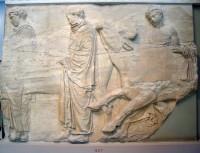
The North Parthenon Frieze, Second block N II, Akr 857 : Sacrificial Procession
Three youths wearing cloaks are driving cattle to sacrifice. The naturalistic rendering of the second cow, lifting up her head and resisting the driver, is especially striking |
|
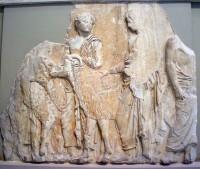
The North Parthenon Frieze, Fourth block N IV, Akr 860 : Sacrificial Procession
Youths wearing cloaks slowly lead rams in sacrifice, a leisurely tranquil scene. In spite of the many overlapping planes, the sculptor has skillfully avoided blurring the outlines of the figures. |
|
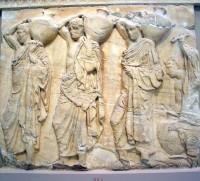
The North Parthenon Frieze, Sixth block N VI, Akr 864 : Water-jar carriers (Hydrophoroi)
The sixth block of the north side: Water-jar carriers (Hydrophoroi), all wearing cloaks. The first three of them carry the “hydrias” on their shoulders, while the fourth one bends down to lift his “hydria” up. Following him is a flutist; one can make out his hands and his double flute. |
|
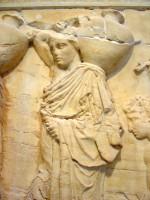
The North Parthenon Frieze, Sixth block N VI, Akr 864: Water-jar carriers (Detail)
The sixth block of the north side: Water-jar carriers (Hydroforoi). Detail of the third jar carrier and the face of the fourth one. |
|
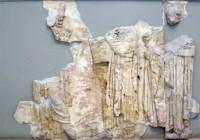
The North Parthenon Frieze, Eighth Block, N VIII, Akr 875: The Musicians
N VIII, 875: The eighth block of the north side depicting four musicians wearing cloaks. Two of them are holding guitars. |
|
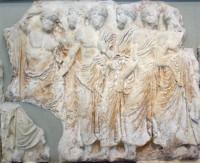
The North Parthenon Frieze: Ninth Block Akr 876, The 'Thallophoroi'
N IX,X. Akr 876+865: The ninth and tenth blocks of the north side. The 'Thallophoroi', aristocratic elders holding olive branches as they take part in the procession. The olive branches are no longer visible as they were shown in paint, which now has completely faded away. |
|
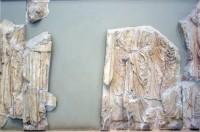
The North Parthenon Frieze: Tenth Block Akr 865, The 'Thallophoroi'
N IX,X. Akr 876+865: The ninth and tenth blocks of the north side. The 'Thallophoroi', aristocratic elders holding olive branches as they take part in the procession. The olive branches are no longer visible as they were shown in paint, which now has completely faded away. |
|
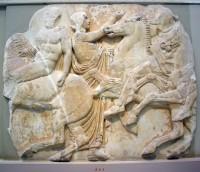
The North Parthenon Frieze: Twenty ninth block, N XXIX, Akr 863
To the left, a naked horseman holding the horse’s reins in his right hand and turning his head to look back. He is back to back with a marshal who signals the riders to keep coming. The figures are modeled with particular sensitivity and they have a beautifully graceful way of moving.
Please note that this slab is the only one depicted in William James Stillman's (1828-1901) photography album "The Acropolis of Athens", captioned as "Fragment of frieze from the Parthenon, 1869" and published in 1870, a milestone in the evolution of monumental architectural photography. |
|
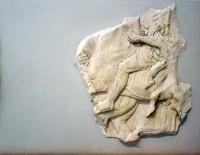
The North Parthenon Frieze: Thirtieth block, N XXX, 861
A rider on a galloping horse; he wears a sleeved chiton and holds the horse’s reins. |
|
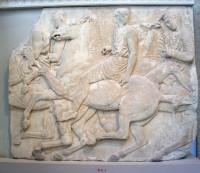
The North Parthenon Frieze: Thirty first block, N XXXI, Akr 862.
Riders on galloping horses. The rider on the right, who wears a sleeved chiton, is adjusting his wreath; the rider in front of him turns to look back. The quick tempo of the horses contrasts with the relaxed bodies of the riders and their tranquil grave features. |
|
Select Page of the Album:
|
|



